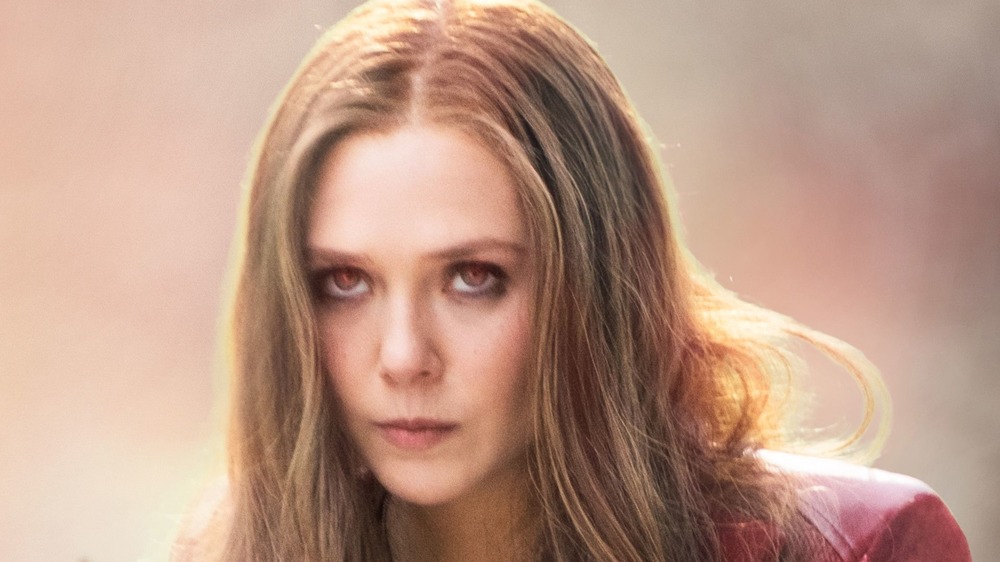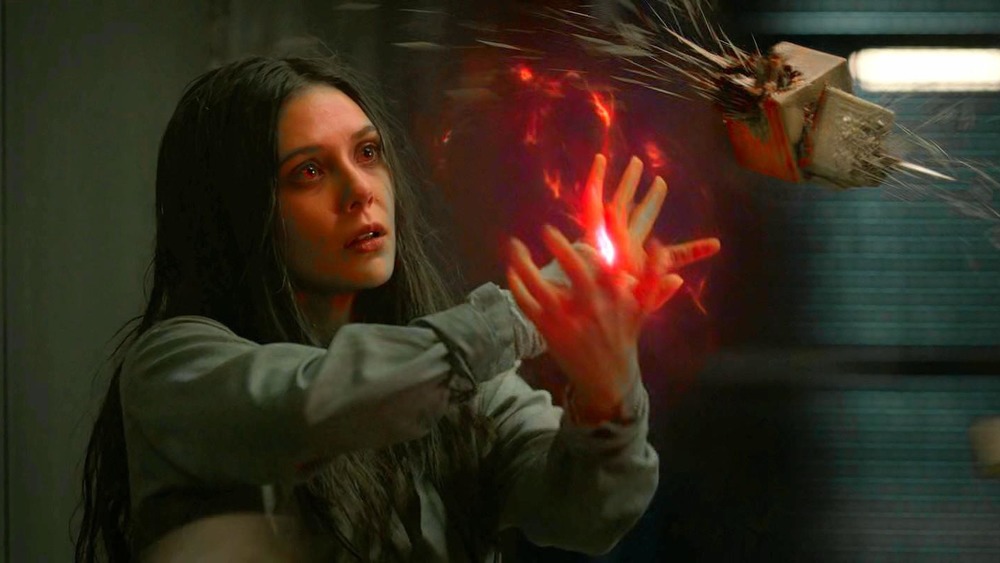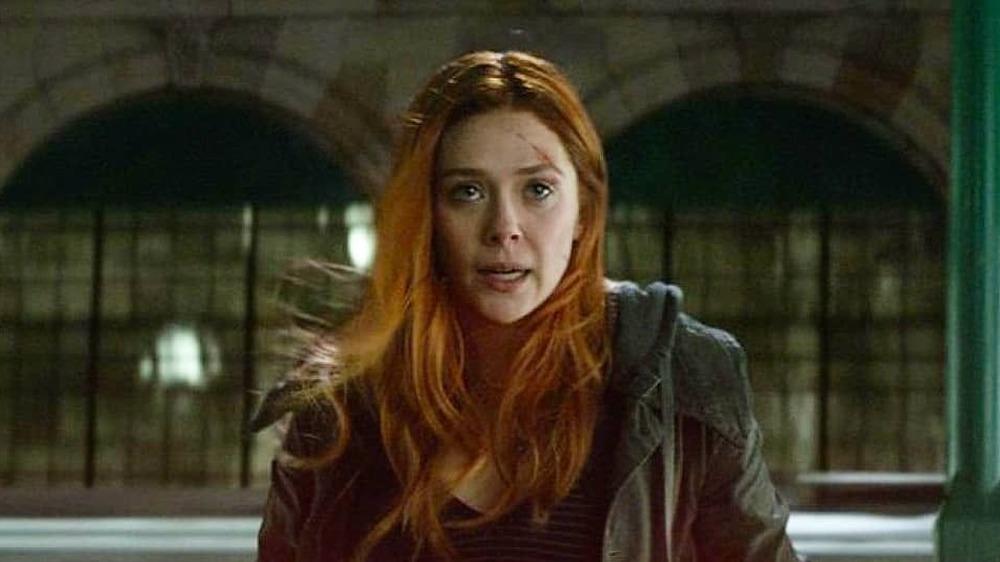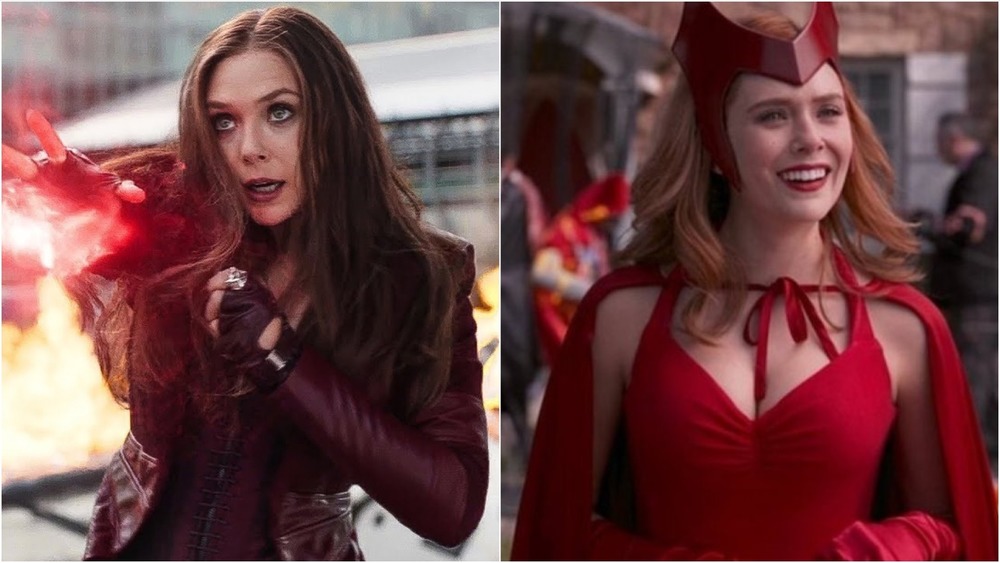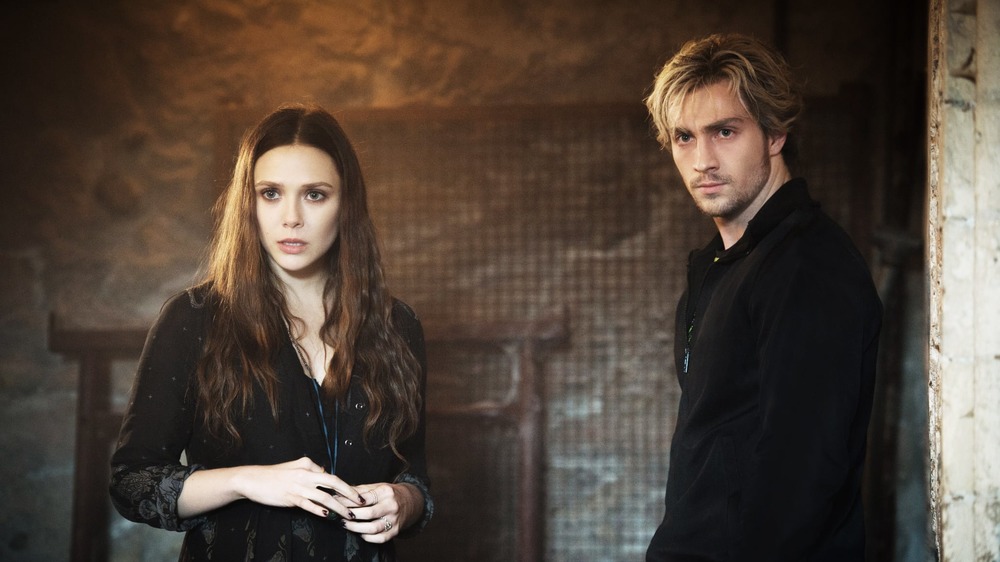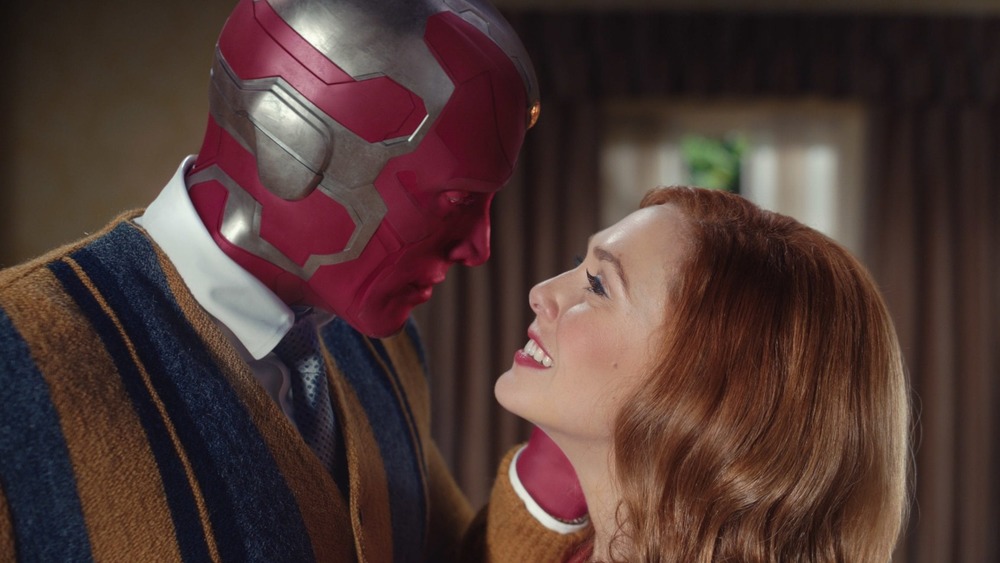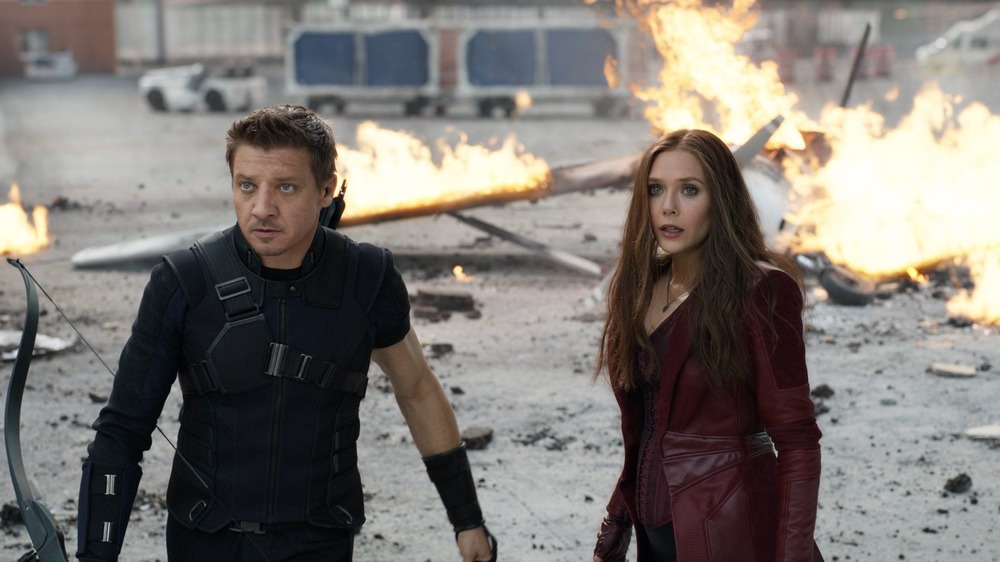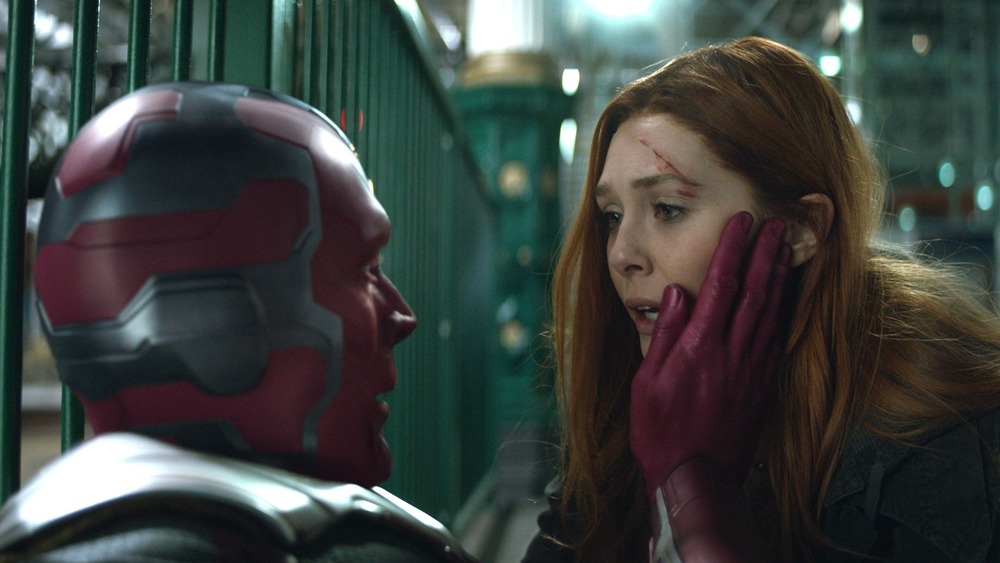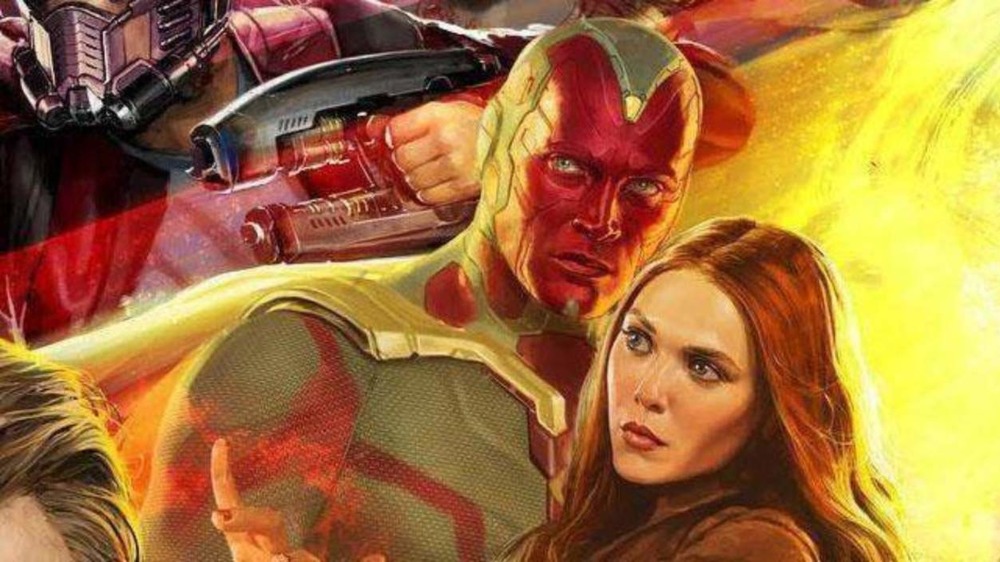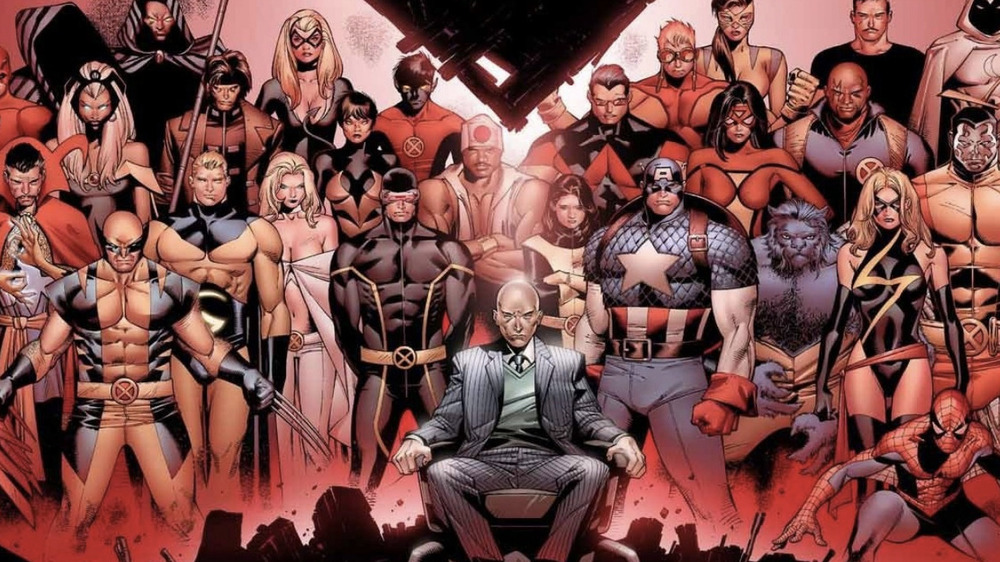The Best Scarlet Witch Easter Eggs In The MCU
Ever since she made her debut in X-Men #4 in March 1964, Wanda Maximoff — a.k.a. Scarlet Witch — has had a significant presence in the Marvel Comics universe. It's only fitting, then, that she'd secure a similarly prominent role in the Marvel Cinematic Universe. Her presence in the MCU has included appearing in five different movies as well as co-headlining the franchise's first Disney+ TV show, WandaVision. Given that Wanda has become such an important character in this expansive media franchise, it shouldn't be a shock that there's also a large number of Easter eggs scattered across the MCU related to her past.
A handful of these Easter eggs are callbacks to the character's earlier appearances in the MCU, while the majority of them are tips of the hat to her various comic book incarnations. Some of those iterations have engaging complex storylines or superpowers that could be tricky to translate into a live-action movie. As a compromise, these Easter eggs work as nods to some of Scarlet Witch's most notable comic book excursions without totally alienating general audiences. Whatever the reason behind these various Easter eggs, they serve as further evidence of Scarlet Witch's importance in Marvel's big-screen mythology.
Tony Stark referring to her as "a witch" in Avengers: Age of Ultron
It can sometimes take a while for Marvel Cinematic Universe characters to take on the colorful names of their comic book counterparts. For example, Rhodey was only offhandedly referred to as a "war machine" by Tony Stark in Iron Man 2, and he didn't officially assume that moniker until Iron Man 3. Wanda Maximoff, on the other hand, has never been called Scarlet Witch in any MCU film — although she did finally acquire the name in an episode of WandaVision.
Prior to that Disney+ program, the closest audiences had gotten to seeing Wanda Maximoff being called Scarlet Witch came during a small piece of dialogue in Avengers: Age of Ultron. In a scene when Tony Stark tries to calm Hulk down after he's been enraged by Wanda Maximoff's superpowers, Stark notes "that little witch is messing with your mind." Wanda never referred to herself as any kind of witch during her subsequent film appearances, but it seems likely that after WandaVision, she'll own her superhero alter ego — Marvel Studios chief Kevin Feige promised audiences that WandaVision would see the character "become Scarlet Witch."
Country of origin
Wanda was introduced to the Marvel Cinematic Universe before Disney purchased Fox, which meant significant portions of her comics backstory needed to be changed. Because Wanda was both a mutant and an Avengers mainstay in the comics, both companies had the film rights to the character. However, both studios were restricted on what they could do with Wanda — as well as her brother Pietro Maximoff, a.k.a. Quicksilver. For Marvel Studios, this shared custody agreement meant that they could use Wanda, but couldn't make her a mutant — or, obviously, the daughter of Magneto. Thus, while Wanda still has a twin brother named Pietro Maximoff in the MCU, her parents are normal human beings.
Another part of her origin story that was altered: The MCU's version of Wanda hails from the European country of Sokovia rather than her original comic book country of origin, Transia. Though the names of the countries have changed, Sokovia bears more than a passing resemblance to Wanda's original homeland. Like Transia, Sokovia is a fictional Eastern European country rife with political turmoil — making it a subtle nod to Wanda Maximoff's original home for comics fans.
Scarlet before Scarlet
Just as she's only recently been referred to as the Scarlet Witch onscreen, Wanda has also largely avoided her traditional comics costume. (The one exception to that rule is when it made a humorous appearance as her Halloween attire in an episode of WandaVision.) As actor Elizabeth Olsen openly admitted, it would be difficult to try and translate that outfit into a serious live-action movie, particularly given that — like a lot of female superhero costumes — it was designed more to titillate male readers than provide any practical complement to Wanda's character or superpowers. However, that doesn't mean the Marvel Cinematic Universe has entirely ignored her traditional comics appearance.
In fact, Wanda Maximoff's regular outfits in the MCU have frequently paid homage to her comic book attire by utilizing that outfit's red color scheme. In Age of Ultron in particular, Wanda wears a jacket whose crimson hue is reminiscent of her comic book costume. That shade has also emerged in subtle traits in her other MCU costumes throughout movies like Avengers: Endgame as well as the color of the magic that emanates from her hands and eyes. Long before she was officially the Scarlet Witch in the MCU, longtime fans knew she was still the character they knew and loved.
Starting out as a bad guy
Not all superheroes start out as superheroes. Some start out like Tony Stark — arrogant people so blinded by their own wealth that they can't see how their actions affect others. Other superheroes begin their journeys as outright supervillains — like Wanda Maximoff, for example. She and her brother Pietro began their time in the Marvel Cinematic Universe as voluntary human guinea pigs for the terrorist organization known as Hydra. These experiments gave them both their superpowers, and they eventually joined forces with the diabolical robot Ultron as his super-powered henchmen. In their time working for Ultron, Wanda and her brother tormented the Avengers and helped lay the groundwork for the maniacal robot's plan for world domination.
While this is different from the duo's origin story in the comics, it isn't a complete change — Wanda also started out as a villain there as well. There, she and Pietro, as the children of Magneto, were critical figures in the Brotherhood of Mutants and frequently fought the X-Men. Much like their film incarnations, though, Wanda and Pietro didn't stay villainous for long. In both mediums, they eventually turned against their evil masters and went on to work for the Avengers — just as comics readers always suspected they would.
Wanda Maximoff rockin' the suburbs
The suburban New Jersey setting of WandaVision is a gift that keeps on giving. On the surface, it allows the show to homage classic sitcoms, many of which (ranging from Bewitched to Modern Family) take place in the suburbs. It works for the show, but it wasn't just invented for TV — this superhero duo's New Jersey roots actually go all the way back to a comic book storyline in the '80s miniseries The Vision and Scarlet Witch.
In that series, the couple moves to the New Jersey suburbs after getting married to enjoy a life together. Unfortunately, it isn't that easy — the locals aren't happy with a human/android marriage happening in their community. That source of conflict in The Vision and Scarlet Witch is more mundane than the supernatural goings-on that fuel the plot of WandaVision, but putting the pair in Westview adds connective tissue to Wanda and Vision's first comic book series — as well as Tom King's 2016 Vision series, which saw the character returning to the suburbs with a new synthezoid family.
Wanda and Hawkeye's relationship
In the MCU, Hawkeye and Wanda Maximoff have developed a close bond since meeting in Avengers: Age of Ultron. Their first big meeting didn't seem to signal that dynamic, though, as it entailed Wanda, still working as a minion of Ultron, trying to sneak up on Hawkeye only for the archer to plug an electrical arrow onto her forehead. However, the two superheroes grew closer once Wanda defected to the Avengers. This was solidified by the climax of Age of Ultron, which saw Hawkeye giving Wanda a big speech about what it means to be an Avenger. His rapport with Wanda took on a paternal sense of protection after her brother Pietro sacrificed himself to save Hawkeye.
This dynamic has continued in subsequent movies, including Captain America: Civil War, when Hawkeye is sent to rescue Wanda and help her remember that she can help people, as well as a small moment at the end of Avengers: Endgame. The pair has also had a close bond in the comics, though it's been more complicated there — specifically because Hawkeye's had romantic feelings for Wanda that put him at odds with Vision. While their relationship has been altered for the movies, Hawkeye and Wanda's MCU closeness echoes the comics.
When Wanda met Vision
While their romantic relationship in the comics happened decades ago, the enormous popularity of WandaVision has ensured that Marvel Cinematic Universe has taken the duo's relationship to a whole new level of prominence. What was once one of many kooky love affairs in the Marvel Comics sphere is now the most well-known romance in all of the MCU. In the movies, the pairing began in the third act of Avengers: Age of Ultron, after Vision is brought to life by Thor's lightning. As he emerges from the chamber that he's been housed in, Wanda gazes upon him in awe. Later, their connection is further reinforced by Vision saving Wanda in Age of Ultron's climax.
In the comics, Wanda first encountered the Vision in Avengers #76. It was a brief meeting, with Vision crossing paths with Wanda as he attempted to rescue her from the clutches of Aakar, but it paved the way for the moment when the Marvel Cinematic Universe would have the characters of Vision and Wanda meet during a larger Avengers adventure.
Life, death and Wanda
In describing how the Star Wars movies have parallels to each other, George Lucas once remarked that "it's like poetry... they rhyme." There's a similar theme of consistency found in the life of Wanda Maximoff in the Marvel Cinematic Universe. The character is always encountering one tragedy after another in this franchise in the form of losing her closest loved ones. Whether it's the death of her parents, the demise of her brother Pietro in Avengers: Age of Ultron, or Thanos murdering Vision in Avengers: Infinity War, heartbreak is a common experience for Wanda. It's understandable that parallels could be drawn between these individual tragedies — but even Wanda's most upbeat moments evoke her most traumatic experiences.
That sense of rhyme is felt in WandaVision when Wanda gives birth to her twins, Tommy and Billy. As she and her neighbor, a disguised Monica Rombeau, bring the babies into the world, the two have a conversation that evokes the dialogue shared by Wanda and Vision in Avengers: Infinity War when Wanda is forced to kill him in order to prevent Thanos from obtaining the Mind Stone embedded in Vision's forehead. The words once used as Wanda took a life are echoed as she experiences giving life: Like Vision, Monica tells Wanda they've run out of time, and to look at her as she reminds Wanda "you can do this." As she did before destroying the Mind Stone, Wanda insists she can't; like Vision, Monica promises her she can. Once you see it, the symmetry here is impossible to ignore.
Bringing down the House of M
Though WandaVision marks the first time Wanda Maximoff has used her superpowers to create an alternate reality in the Marvel Cinematic Universe, it's something she's accomplished in the comics before. In fact, her abilities in this department were the crux of the famous House of M comic book storyline penned by Brian Michael Bendis in 2005. Here Wanda, much like in WandaVision, is in a period of deep emotional distress — though in House of M her grief is the result of losing her children. To cope with her crushing sadness, Wanda decides to escape by creating her own reality. This decision doesn't just impact Wanda, though — it sends the entire Marvel Universe into chaos, ultimately depriving most of the mutants in the world of their superpowers.
Looking at House of M's broad strokes, it's clear WandaVision takes cues from this comics event, including the emphasis on Wanda navigating very real emotional problems through her superpowers. There are clear and major differences between the comics and the show, but the parallels between WandaVision and House of M are impossible to miss.
